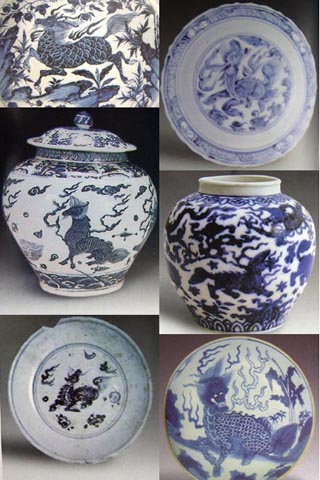
Qilin (Chinese: 麒麟 or 騏驎; pinyin: qílín; Wade-Giles: ch’i²-lin²), also known as keilun in Cantonese, is a mythological creature of originally Chinese origin. Like a chimera, it is described as having a body composed of parts from various animals. Despite its often fierce appearance, it is considered an auspicious creature that symbolizes peace and serenity.
Qilin (Chinese: 麒麟 or 騏驎; pinyin: qílín; Wade-Giles: ch’i²-lin²), also known as keilun in Cantonese, is a mythological creature of originally Chinese origin. Like a chimera, it is described as having a body composed of parts from various animals. Despite its often fierce appearance, it is considered an auspicious creature that symbolizes peace, benevolence, and serenity.
Qilin is the standard pinyin transliteration of the Chinese word 麒麟, common in scholarly or modern writing. Kylin is an older transliteration, frequently used in 19th- and early 20th-century Western texts, where the term has become somewhat conventional. Both refer to the same mythological creature.
It symbolizes benevolence and rectitude and its appearance is seen as a good omen. In Chinese mythology, the Qilin is a herald of the birth or death of a sage or illustrious ruler. The name combines the two characters qi (male) and lin (female), reflecting a balance of yin and yang. A Qilin is said to have a single horn on its forehead, a yellow belly, a multicolored back, the hooves of a goat, the body of a deer, the tail of an ox, and sometimes the head of a dragon. Gentle by nature, it does not tread on green grass or eat living vegetation.
In some traditions, the Qilin is also listed among the nine sea monsters. Sometimes it is said to have the head of a dragon, the scaled body of a deer, the tail of a Buddhist lion, and the hooves of a goat. In art, it is sometimes mistaken for a deer.
The first Qilin is said to have appeared in the garden of the legendary Yellow Emperor (Huangdi) in 2697 BC. About three centuries later, a pair of Qilin reportedly appeared in the capital of Emperor Yao - both events seen as divine confirmation of benevolent rule.
The advent of the great sage Confucius (6th century BC) was similarly marked by the appearance of a Qilin to his pregnant mother. The creature is said to have coughed up a jade tablet foretelling the greatness of the unborn child. Later, the death of Confucius was foreshadowed when a Qilin was struck and injured by a charioteer.
In 1414, a live giraffe was brought to China and presented as a Qilin to the Ming emperor Yongle (r. 1403–1425). The emperor, an experienced military ruler, was unimpressed and famously remarked that he was no sage and the animal no Qilin. Nonetheless, the association between giraffe and Qilin persisted—today, the Japanese word for giraffe is kirin, written with the same characters as Qilin.
A Qilin is a fabulous creature that appears in various forms and is often associated with the wish for sons. Although sometimes described in English as a “unicorn,” this is misleading, as the Qilin can have more than one horn.
The Qilin was also used as a symbol of rank, appearing on the badges of rank for military officials of the First Grade during the Qing dynasty.
In mythology, the Qilin was associated with the Kunlun Mountains and represented good fortune, fertility, and filial piety. These attributes highlight its close ties to Confucianism. According to Confucian legend, the Qilin appeared to Confucius’s mother shortly before his birth, reinforcing its role as a divine herald.
The Qilin appears in Chinese art as early as the Han dynasty and was a frequent motif in Han ceramic tiles and Tang sculptures. It is mentioned in Han poetry and the Shujing (Classic of History), and Qilin sculptures are often found guarding tombs from the 5th century AD onwards.
Since the Qilin is a mythological creature and there are no Qilins, descriptions vary. The above is a compilation from various sources that covers the general thoughts of this motif in various contexts.
A